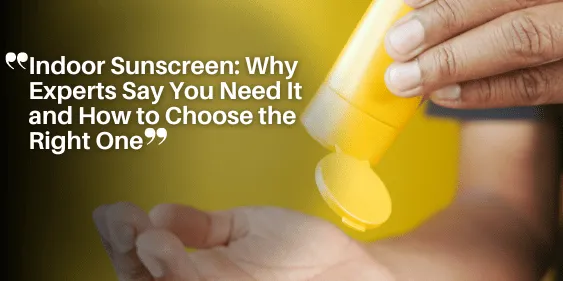Indoor Sunscreen: Why Experts Say You Need It and How to Choose the Right One

Many people associate sunscreen use with bright, sunny days outdoors, yet dermatologists emphasize its importance even inside our homes. Surprisingly, harmful UV rays and blue light don’t just exist outside; they also infiltrate indoor environments, posing risks to skin health.
Indoor UV Exposure: The Hidden Threat
UV rays can penetrate windows and screens, making their way indoors. Both UVA and UVB rays are culprits:
- UVA rays penetrate deep into the skin, causing long-term damage like wrinkles and increasing cancer risk.
- UVB rays primarily inflict surface-level damage, resulting in sunburn and exacerbating cancer odds.
Blue Light: The Digital Villain
Beyond UV rays, blue light—emitted by screens and LED lights—also contributes to skin damage. Prolonged exposure to blue light can accelerate aging and cause hyperpigmentation. This makes indoor sunscreen crucial for those who spend extended time in front of screens.
Indoor Sunscreen Benefits
By applying sunscreen indoors, you protect your skin from these harmful effects. It acts as a barrier against:
- Skin damage
- Premature aging
- Potential skin cancer
Wearing sunscreen indoors is an essential step towards comprehensive skin health.
With an understanding of these risks, you’re better prepared to explore which sunscreens offer the most effective protection.
Understanding Different Types of Light Exposure Indoors
UVA Rays: Deep Penetration and Long-Term Damage
UVA rays are the sneaky troublemakers of the light spectrum. They penetrate deep into your skin, reaching the dermis – the skin’s thickest layer. Their effects might not be immediately obvious, but they’re significant. Long-term exposure to UVA rays can lead to wrinkles, age spots, and, more worryingly, skin cancer. As Dr. Danilo Del Campo from the Chicago Skin Clinic notes, their impact accumulates over time, making them a silent threat that can cause considerable harm in the long run.
UVB Rays: Surface-Level Threats and Sunburn
UVB rays primarily harm the skin’s surface. Known for their role in causing sunburn, they are more intense, especially during certain times of the day and year. While their effects might be more immediate and noticeable, such as redness and irritation, the danger doesn’t stop there. UVB rays also increase your risk of skin cancer. Regular sunscreen use is vital to mitigate these risks, especially during peak sunlight hours.
Blue Light: The Digital Dilemma
Then there’s blue light – the kind emitted by digital screens and LED lighting. This type of light has recently become a significant concern for skin health. According to Dr. Del Campo, prolonged exposure to blue light accelerates skin aging and contributes to hyperpigmentation due to oxidative stress. It’s not just your eyes that need protection from your devices; your skin does too.
Understanding these different types of light exposure underscores the importance of using indoor sunscreen. By being aware of the various forms of light that can affect your skin, you can better protect yourself and maintain healthy, youthful skin.
Moving forward, we’ll dive into how to choose the right sunscreen for indoor use.
Why Indoor Environments Aren’t as Safe as You Think
Penetration of UVA and UVB Rays Through Glass
Many people believe they are safe from harmful UV rays when indoors, but this is far from the truth. Both UVA and UVB rays can easily penetrate glass windows, posing significant risks to your skin. While UVB rays primarily cause sunburns and immediate skin damage, UVA rays penetrate deeper into the skin, leading to long-term damage such as wrinkles, age spots, and an increased risk of skin cancer. This means that working near a sunny window all day can be just as harmful as spending time outdoors without sunscreen.
Increased Blue Light Exposure from Screens
Prolonged screen time, whether from computers, tablets, or smartphones, has become a staple of modern life, especially as more people work from home. However, the blue light emitted from these devices can accelerate skin aging and cause hyperpigmentation. Blue light generates oxidative stress in the skin, which contributes to the breakdown of collagen and the appearance of fine lines and wrinkles. Additionally, prolonged exposure can exacerbate pigmentation issues, making it a growing concern for comprehensive skin health.
Limited Protection from Car Windows
Many assume that the glass in car windows provides substantial protection against UV rays, but this is misleading. While car windows block most UVB rays, they offer minimal protection against UVA rays. This means that even short drives can expose you to harmful radiation, contributing to long-term skin damage. For this reason, dermatologists recommend applying sunscreen even when you’re only commuting.
Understanding these hidden dangers of indoor environments highlights the importance of using sunscreen and other protective measures, even when you’re not directly under the sun. By being mindful of UV and blue light exposure indoors, you take essential steps toward maintaining long-term skin health.
Choosing the Right Sunscreen for Indoor Use
Mineral Sunscreens: Physical Protection
Mineral sunscreens are an excellent option for indoor use as they create a physical barrier on the skin. Ingredients like iron oxide and titanium dioxide effectively block both UV and blue light. This type of sunscreen sits on the skin’s surface and reflects rays away, ensuring your skin remains shielded without absorbing the harmful effects. [Dr. Gmyrek](Do you need sunscreen indoors.docx) emphasizes the effectiveness of these substances in blocking UV and blue light, making them ideal for comprehensive protection indoors.
Chemical Sunscreens: Absorptive Defense
Chemical sunscreens offer a different form of protection by absorbing UV radiation and converting it into heat, which the skin then releases. This method ensures the harmful rays do not penetrate deeper layers of the skin. One of the significant advantages of chemical sunscreens is their less visible appearance on the skin, as noted by [Dr. Del Campo](Do you need sunscreen indoors.docx). This makes them an attractive option for those looking for a more inconspicuous form of UV protection.
Hybrid Sunscreens: Combining Benefits
Hybrid sunscreens offer the best of both worlds, combining the robust physical shielding of mineral sunscreens with the absorptive nature of chemical sunscreens. These products cater to varied skin types and personal preferences, making them versatile for everyday indoor use. [Dr. Hadley King](Do you need sunscreen indoors.docx) recommends choosing a broad-spectrum SPF 30+ sunscreen to ensure comprehensive protection against a range of harmful rays.
Choosing the right sunscreen for indoor use is all about understanding your specific needs and preferences. Whether you opt for a mineral, chemical, or hybrid sunscreen, the key is to ensure it offers broad-spectrum protection to keep your skin healthy and youthful, no matter where you are.
Proper Application of Indoor Sunscreen
Apply to Exposed Areas
Even while indoors, certain parts of your body remain exposed and thus, vulnerable to UV and blue light. Dermatologists recommend that you apply sunscreen generously to regions like the face, neck, chest, and hands. These areas are usually uncovered and consistently hit either by sunlight streaming through windows or by blue light from screens.
Quantity Matters
When it comes to sunscreen, the quantity you apply plays a crucial role in its effectiveness. A good rule of thumb is to use a nickel-sized amount for the face. Ensure even distribution to cover all exposed areas adequately. Extend the application to your neck and chest, and don’t forget your hands, as they are often overlooked despite frequent exposure.
Adjust Based on Exposure Levels
Not all indoor settings offer the same level of light exposure. If you’re spending most of your time near a window or in front of screens for prolonged periods, it’s wise to apply sunscreen more liberally. For those quick moments when you step out or if your workspace is bathed in indirect sunlight, a lighter application can suffice.
Remember, reapplication is key, especially if you’re in high-exposure environments. This habit ensures that your skin continues to receive optimal protection throughout the day.
Making these application techniques part of your daily skincare routine not only safeguards your skin from immediate harm but also contributes to your long-term skin health.
Additional Measures for Indoor Sun Protection
Strategic Placement
One of the simplest ways to reduce UV exposure indoors is by strategic placement within your environment. Positioning workspaces and relaxation areas away from windows can minimize direct UV ray exposure. Although glass blocks some UVB rays, UVA rays can still penetrate and reach your skin, leading to potential long-term damage.
Use Protective Gear
Another effective measure is incorporating UV-protective clothing into your daily attire. These clothes are designed to block harmful UV rays and offer an added layer of protection. Additionally, investing in screen protectors for your digital devices can help minimize blue light exposure from screens, which contributes to aging and hyperpigmentation.
Install Window Films or Shades
Finally, installing window films or shades is a proactive step for enhancing indoor sun protection. Window films with UV-filtering properties can significantly reduce the amount of UVA and UVB rays that penetrate through glass, while shades offer a practical barrier during peak sunlight hours. These adjustments not only safeguard your skin but also create a healthier living environment.
By adopting these additional measures and consistently incorporating sunscreen into your routine, you create a comprehensive defense strategy that promotes long-term skin health and resilience.
Conclusion: Embracing a Holistic Approach to Skin Health
Indoor sunscreen isn’t just a trend; it’s an essential aspect of a thorough skincare regimen. Your skin faces exposure to various harmful rays even when you’re indoors, accelerating aging and increasing health risks. Understanding and implementing indoor sun protection can make a significant impact on your skin’s long-term health.
Indoor Sunscreen: The Core of Comprehensive Skin Protection
Dermatologists now stress using sunscreen indoors thanks to UVA and UVB rays penetrating glass windows and blue light from screens. Regular application of sunscreen can:
- Prevent premature aging and hyperpigmentation caused by UV and blue light exposure.
- Reduce the risk of skin cancer from prolonged UV exposure.
Adopting Preventive Measures
Sunscreen application is crucial, but it isn’t the sole measure for protecting your skin. Other preventive strategies include:
- Strategic Placement: Relocate workspaces away from windows to minimize direct sunlight exposure.
- Protective Gear: Wear UV-protective clothing and consider screen protectors for your devices.
- Additional Barriers: Install window films or shades to block out harmful UVA rays more effectively.
Consistent Habits for Long-Term Wellness
Adhering to these protective measures daily ensures your skin stays vibrant and healthy. Consistency is key:
- Apply sunscreen to your face, neck, chest, and hands every morning.
- Reapply as needed, particularly if you’re exposed to prolonged screen time or sitting near windows.
- Combine sunscreen use with the strategic placement of furniture and other protective equipment.
A holistic approach to skin health means integrating these practices into your daily routines. Protecting your skin from indoor environmental stressors not only guards against immediate harm but also contributes to long-term wellness, keeping your skin youthful and resilient for years to come.







